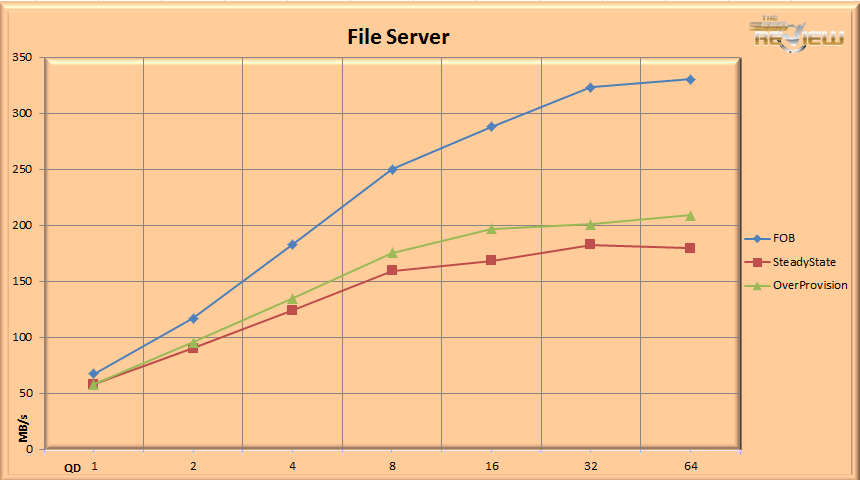SERVER PROFILES
The FOB, Steady State, and over provisioned performance testing continues across 4 profiles that are constructed to simulate different types of server access during real life usage.
The File Server profile emulates usage in a file server environment with a vast range of file sizes being accessed simultaneously. The access is 80% Read and 20% Write, which actually lends itself very well to the strengths of the Toshiba drive right out of the box. With 90K Read IOPS and 16K write IOPS under Steady State conditions, the SSDs specifications line up very well with this type of usage. There is also a negligible performance gain from the OP, as the drive is already well-suited for this task.
 The Email profile is an emulation of a mail server, with a 50% Read and 50% Write mixed workload with very small 8KB files. This can be a very stressful test for even the best of drives. There is a drastic difference in the FOB compared to the Steady State performance, but this is to be expected with these extreme Read/Write mixed workloads.
The Email profile is an emulation of a mail server, with a 50% Read and 50% Write mixed workload with very small 8KB files. This can be a very stressful test for even the best of drives. There is a drastic difference in the FOB compared to the Steady State performance, but this is to be expected with these extreme Read/Write mixed workloads.
 The Toshiba excels at the Web Server simulation, as it is Read-only through a various spate of file sizes. The drive sings along at 23,000 IOPS at a Queue Depth of 32, or 402 MB/s. At a Queue Depth of 32 the speed is a remarkable 25,000 IOPS and 402 MB/s. Of note is the fact that all 3 states of the drive receive very nearly identical scores. Read-only profiles and usages will remain largely unaffected by Steady State conditions, and for a drive with Toshiba’s massive Read speed, this only equals excellent performance!
The Toshiba excels at the Web Server simulation, as it is Read-only through a various spate of file sizes. The drive sings along at 23,000 IOPS at a Queue Depth of 32, or 402 MB/s. At a Queue Depth of 32 the speed is a remarkable 25,000 IOPS and 402 MB/s. Of note is the fact that all 3 states of the drive receive very nearly identical scores. Read-only profiles and usages will remain largely unaffected by Steady State conditions, and for a drive with Toshiba’s massive Read speed, this only equals excellent performance!
 The Database/OLTP (On-Line Transaction Processing) profile is another heavy-usage type of access that can bring many drives to their knees given Steady State conditions. This drive performs very well at this test as it is tuned for Steady State usage from the onset. The OP that is used also demonstrates great gains in speed here, a perfect 20% scaling.
The Database/OLTP (On-Line Transaction Processing) profile is another heavy-usage type of access that can bring many drives to their knees given Steady State conditions. This drive performs very well at this test as it is tuned for Steady State usage from the onset. The OP that is used also demonstrates great gains in speed here, a perfect 20% scaling.
OLTP is in essence the processing of credit card transactions, and requires the utmost speed and reliability, a area that the Toshiba excels at. With 8KB being accessed with a 33% Write and 67% Read ratio, this drive does very well.
 The SSD Review The Worlds Dedicated SSD Education and Review Resource |
The SSD Review The Worlds Dedicated SSD Education and Review Resource | 
Thanks for the detailed report. Can you compare/contrast this with the OWC enterprise drive, which is 1700 vs 6000 for the Toshiba. Is it worth 3 times the price? I do see the attention they paid to heat and don’t know if OWC has done the same homework, but the OWC drive does use an enterprise SandForce chip which should have the same features as the Marvell.
Awaiting arrival of the OWC SSD.
I guess the price difference is SLC vs eMLC, (correct me if I’m wrong) and their additional work on putting it together really well in terms of the heat dissipation. But in real terms I guess this comes down to longevity? It would be very interesting if you could do some applied but theoretical analysis of longevity comparisons. For example, if serving a database or web server with x writes and y reads per day how long would each last? I think the SLC is in the millions so that can be counted on for 5 yrs+ but the question is, with the features of the enterprise SF chip, what life can be expected there? The speed should be comparable, maybe with a slight bump for this drive in IOPS.